- Introduction to Bhutan
- 1. A Unique and Gentle Country
- 2. On the Rough Road to Thimphu
- 3. Punakha Dzong & Buddhism
- 4. Hand Built Roads
- 5. Gross National Happiness
- 6. Moving Toward Democracy
3. Punakha Dzong & Buddhism

On the West Coast of the United States where I live, any structure standing for 100 years is considered old. Imagine how I felt when we visited some of Bhutan’s traditional dzongs (pronounced zong), first built in the 12th century. These are enormous stone structures built as fortresses and administrative centers, often on top of existing temples, and later used as fortresses to defend the former Buddhist kingdoms of Bhutan, Tibet, and Himalayas in the 1600s. When I finally stood next to one, I was in awe of the massive towering exterior walls, surrounding complex courtyards, temples, monks’ living quarters, and administrative offices.
Pema, who answered questions about all things Bhutanese, brimmed with information about the history, construction, and use of the dzongs. In the early 1600s, the Tibetan Buddhist lama Zhabdrung Ngawang Namgyal unified the warring tribes into a nation-state now known as Bhutan. He wanted to create a distinct Bhutanese culture separate from Tibet, so he commanded that more of the massive dzongs be built.
Today, trekkers can find the remote dzongs clinging to impossible cliffs and other locations strategically chosen to defend against warring neighbors. .
Morning Birding
On our fourth day of birding, we arose before dawn to catch the early birds as usual. We were staying in the town of Punakha located fourteen miles northeast of Thimphu on the map, twice as far by the twisty road. Punakha was the original capital of Bhutan and home to one of the country’s oldest and most beautiful dzongs. We passed the massive whitewashed walls of Punakha Dzong on our way out of town. Constructed on a point of land at the confluence of two rivers, the dzong shone in the first rays of the morning sun. I eagerly anticipated our visit to Punakha Dzong after our morning birding.
We drove slowly up the Pho Chhu Valley for about two hours, stopping frequently as the birds woke up and began moving. In the morning shadows of the steep-sided valley, we encountered a variety of birds, including the hard-to-find Tawny Fish-owl, Slaty-bellied Tesia, Bay Woodpecker, a beautiful blue Verditer Flycatcher, the impressive Slender-billed Scimitar-babbler, noisy flocks of the Nepal Fulvetta, and a Maroon Oriole. At our lunch stop, we enjoyed a shimmering blanket of yellow and black butterflies clustered at the edge of a small stream, sipping the moisture from the wet sand. On birding trips, I always love that we see so much more than the birds we are seeking.
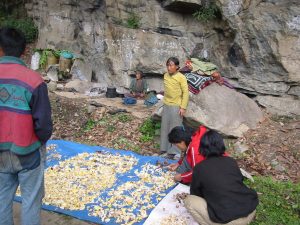
Pema scanned the river as we drove back down the valley. Suddenly, he raised his voice to the driver who slammed on the brakes. He pointed to two tall birds standing at the edge of the fast flowing water. Richard jumped off the bus, took a look through his binoculars, and turned to us with a big smile on his face.
“Good spot, Pema! White-bellied Herons, also called Imperial Herons,” he said as we all positioned ourselves for a good view of the long-necked birds. Their grey bodies disappeared into the grey river rocks, making Pema’s discovery even more incredible. “These herons used to breed in this valley years ago, but now they are endangered and hard to find, especially at this time of year,” Richard explained.” I can see a bit of breeding plumage, so maybe they are nesting in the area again. The best estimates are that only 250 to 1,000 white-bellied herons remain.”
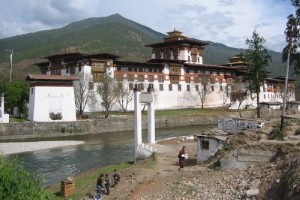
Thrilled with a great morning of birding, our next stop was just as exciting for me—visiting a dzong, one of the iconic structures so key to Bhutan’s history. My first impression as we walked up to Punakha Dzong was, What a massive structure! The monastery fortress built more than five centuries earlier, was heavy and thick in its architectural appearance. It had formidable tilted walls that made it look totally impregnable, which was the point.
Chhu means river, and the Punakha Dzong is located at the confluence of the Mo Chhu (Mother River) and the Pho Chhu (Father River). It is close to the town of Punakha, and is the second oldest, and the second largest dzong in Bhutan. Punakha Dzong is one of six dzongs in Bhutan still used as a monastery and it is considered one of the most majestic. Until the mid-1950s, Punakha Dzong was the seat of the Bhutanese government, and today it is still the winter residence of the dratshang, the central Buddhist monk body.
In 1637, Shabdrang Ngawang Namgyal, who first united the fiefdoms in Bhutan, ordered the construction of the Punakha Dzong on the site of a smaller structure built in 1326 that housed a statue of Buddha. Since then, Punakha Dzong has survived fires, earthquakes, and flooding from the two rivers. The repairs from a 1994 flood have returned much of the dzong to its original state. The whitewashed, beaten mud, and stonewalls contrasted with the dzong’s dark wooden beams, window frames, and roof.
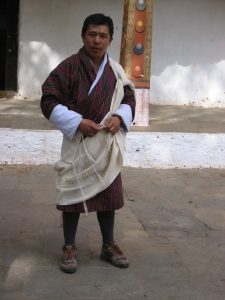
Pema wore an especially formal gho for the day and had brought a white scarf for his visit to the dzong. Every Bhutanese person must wear a scarf indicating his or her status when visiting the dzongs. Colored scarves are reserved for royals, Buddhist ranks, and government officials. Everyone else wears a white scarf. Before leaving our bus for the dzong, Pema draped his scarf across one shoulder and carefully fastened it in a particular manner that looked more like a fold than a knot.
We approached the dzong via a short suspension bridge over the Mo Chhu, a temporary bridge that replaced the older one ripped from its foundations during
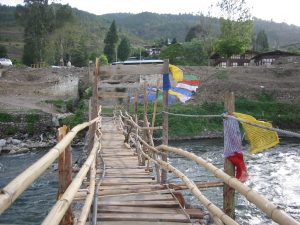
the 1994 flood. Stepping carefully across the uneven planks, I felt anxious suspended over the wildly rambunctious water thrashing close to my feet. The bridge felt quite steady as I crept along and my confidence increased. I paused in the middle of the bridge, savored the thrill of danger, and recalled other hanging bridges we had seen on our trip that clung to the lips of deep canyons. I thought, Should the worst occur, I would not have a long drop. I would, however, have a rather rough ride in the water.
With that thought, I picked up my pace to get off that bridge.
A couple of older men in faded clothing loitered at the gate that pierced the ten-foot-high perimeter wall. They watched the monks, tourists, and civil servants coming and going. We all greeted the men with a smile and passed through the gate.
 Inside the outer wall, the main buildings towered above us. We paused to appreciate the quiet well-tended gardens with only a few strolling monks and their visitors. Designed as a fort, there is no ground-level entrance to the dzong itself, which would deter a surprise attack. We had to walk up a long flight of steep steps leading to an open roofed foyer. Each stair step was much higher than our standard stairs and any enemies trying to rush the place would be winded by the time they reached the top!
Inside the outer wall, the main buildings towered above us. We paused to appreciate the quiet well-tended gardens with only a few strolling monks and their visitors. Designed as a fort, there is no ground-level entrance to the dzong itself, which would deter a surprise attack. We had to walk up a long flight of steep steps leading to an open roofed foyer. Each stair step was much higher than our standard stairs and any enemies trying to rush the place would be winded by the time they reached the top!
While we listened to Pema offer details on the dzong, I noticed three high-school-age monks with shaved heads and red robes lounging on the top steps, possibly taking a break from their studies. I pointed my camera toward them and one held up his hand to signal no photo. Oops! Too late! I thought as I snapped a photo. They must see many tourists taking photographs, so I felt a bit ashamed that I had not respected their monastic privacy. We were, after all, visiting a religious place of education and worship, not a tourist attraction.
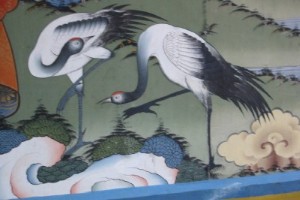 We struggled up the steep steps to the entry foyer where bright, colorful murals depicting the life of Buddha and various deities covered the walls. Carved and painted intricate detail covered every wooden surface. As Pema explained the figures, he spun one of the two large prayer wheels that flanked the entry door. The mantra in each wheel invokes benevolent attention, and each rotation of the wheel spreads spiritual blessings and well-being.
We struggled up the steep steps to the entry foyer where bright, colorful murals depicting the life of Buddha and various deities covered the walls. Carved and painted intricate detail covered every wooden surface. As Pema explained the figures, he spun one of the two large prayer wheels that flanked the entry door. The mantra in each wheel invokes benevolent attention, and each rotation of the wheel spreads spiritual blessings and well-being.
The Monks’ Daily Ceremony
We entered an inner courtyard where painted flowers and leaves, delicate Bhutanese script, animals, and gilded garlands decorated the interior walls, posts, and beams. Discrete wall niches displayed small replicas of Buddha. All the color and texture overwhelmed me, so I turned with relief to the ancient, thick-leaved almond tree in the center of the courtyard. House sparrows chirping in the old tree helped ground me.
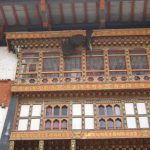 From the sunny courtyard, Pema invited us to observe the monks’ daily afternoon ceremony. Another set of steep stairs made me wonder if they were built with a high rise to give the monks exercise as they went about their daily activities. As we approached the next set of stairs, we could hear the deep moans of horns, crisp drumbeats, and bright cymbal clashes. The heavy wood interior, darkened by centuries of incense burning, absorbed much of the light that entered through small openings high in the roof. The dim light added an element of mystery to the interior.
From the sunny courtyard, Pema invited us to observe the monks’ daily afternoon ceremony. Another set of steep stairs made me wonder if they were built with a high rise to give the monks exercise as they went about their daily activities. As we approached the next set of stairs, we could hear the deep moans of horns, crisp drumbeats, and bright cymbal clashes. The heavy wood interior, darkened by centuries of incense burning, absorbed much of the light that entered through small openings high in the roof. The dim light added an element of mystery to the interior.
We crossed the open floor of the balcony and peered over the railing at the scene below. Perhaps 50 monks draped in cranberry-colored robes sat like red pyramids on the uncluttered wooden floor. The horns boomed their reverberating note again from beneath my feet. Moving to a better spot, I found the horn players sitting against one wall tucked under the balcony, the ten-foot-long wooden and brass horns stretched straight out in front of them. I wondered if that could be what an unwound tuba or sousaphone might look like. It must have taken terrific lung volume to make any sound emerge from those huge instruments, much less the full reverberating sounds that filled the large hall. I got dizzy just thinking about it.
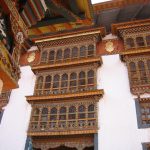 On the platform next to the horns, a chanting monk reverently fingered the ancient book that lay before him, even though he seldom needed to glance at it. Two lines of monks facing one another stretched away from the chanting monk across the hall. Each monk in the front row held a slim pole planted firmly on the floor. At the top of the six-foot-pole a small, flat, two-sided drum swayed a little as a monk beat it with a long drumstick. The drumstick was thin and straight to the upper end and then curved in a crescent so the padded tip struck the drum at a right angle to the head. The ping from the tenor drums balanced the labored, deep notes from the horns. The precision and unity as the drummers responded to the chanting monk fascinated me.
On the platform next to the horns, a chanting monk reverently fingered the ancient book that lay before him, even though he seldom needed to glance at it. Two lines of monks facing one another stretched away from the chanting monk across the hall. Each monk in the front row held a slim pole planted firmly on the floor. At the top of the six-foot-pole a small, flat, two-sided drum swayed a little as a monk beat it with a long drumstick. The drumstick was thin and straight to the upper end and then curved in a crescent so the padded tip struck the drum at a right angle to the head. The ping from the tenor drums balanced the labored, deep notes from the horns. The precision and unity as the drummers responded to the chanting monk fascinated me.
One drumstick did not seem to be in synch with the others. In fact, it seemed the monk holding it was weaving a little, dozing off, perhaps. No one seemed bothered. He jerked awake and joined the others for a few more strikes, then dozed off again. One or two of the others smiled a bit, but no one attempted to wake him. I delighted in this bit of humanness amidst the reverence in this centuries-old ceremony.
Behind each line of drumming monks sat two more red rows of monks. Occasionally, one would get up and walk out. Another would enter, find an unoccupied spot, and settle among his brother monks. Once again, mesmerized by what I saw, questions arose about Bhutan’s culture and lifestyle. I wondered, What can I draw from this? Is this ceremony optional? Do the monks come and go when other duties allow? Do the ones who do not come demonstrate a lack of commitment?
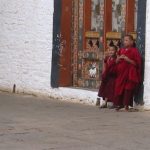 I moved to the other side of the balcony where an older monk also watched the activities below. When the drumming finished, the monks laid down their drums and sat in silence. After a pause, a young monk with a container full of uncooked grain emerged from a dark door in the wooden wall. He stopped in front of each monk and scooped a handful of uncooked rice into each man’s lap. On cue from the reader, each monk pinched a bit of grain and tossed it with a flick of the wrist. Most did so without obvious concern where it landed. Some threw it high into the air, and one of the youngest monks, a teenager, clearly had a target in mind. He grinned broadly after several tosses in a specific direction, though I could not pinpoint the recipient of his attention. I glanced at the elderly monk who had to have seen the antics, but he seemed undisturbed, neither a smile nor a frown. Did he remember being a boy himself?
I moved to the other side of the balcony where an older monk also watched the activities below. When the drumming finished, the monks laid down their drums and sat in silence. After a pause, a young monk with a container full of uncooked grain emerged from a dark door in the wooden wall. He stopped in front of each monk and scooped a handful of uncooked rice into each man’s lap. On cue from the reader, each monk pinched a bit of grain and tossed it with a flick of the wrist. Most did so without obvious concern where it landed. Some threw it high into the air, and one of the youngest monks, a teenager, clearly had a target in mind. He grinned broadly after several tosses in a specific direction, though I could not pinpoint the recipient of his attention. I glanced at the elderly monk who had to have seen the antics, but he seemed undisturbed, neither a smile nor a frown. Did he remember being a boy himself?
When the raw rice was finished, most of the monks unfolded a white cloth that each one placed in his lap. Two younger monks entered with large pots of boiled white rice, their bare feet shushing as they moved down the line. Stopping in front of each monk, they pushed a small saucepan into the pot and plopped a lump of sticky rice onto the cloth. The recipients knotted their cloths and put them aside. Some monks got more rice than others. Some had not spread their cloth and the providers passed by them. Once again, questions popped into my mind. What could all this mean?
I had so many questions: Was I just reading more than what was intended into a daily activity? Possibly a monk was on a diet? Fasting? Was this voluntary or imposed?
In the end, my questions faded as even more questions took their place.
What Is, Is
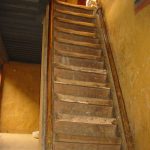 When Pema signaled for us to leave, we descended another set of perilous wooden steps to a smaller courtyard. The steps were higher than I am used to, so I ran my hand along the wall to steady myself.
When Pema signaled for us to leave, we descended another set of perilous wooden steps to a smaller courtyard. The steps were higher than I am used to, so I ran my hand along the wall to steady myself.
The ceilings of the halls were very high, so the outside of the building was as tall as a five- or six-story building. Big and small windows with little balconies broke the expanse of white walls. We took some time to appreciate the detailed carvings and paintings on every inch of the wood.
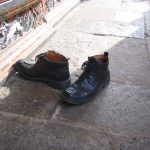 Pema led us across the courtyard to another hall. We could see through a doorway where younger monks gathered. I assumed they had just finished the same ceremony we had witnessed because rice grains remained on the polished floor. Pema indicated we should remove our shoes outside since we were entering the actual hall, not just observing from above. There was no balcony, but the interior was dark and cavernous like the other one.
Pema led us across the courtyard to another hall. We could see through a doorway where younger monks gathered. I assumed they had just finished the same ceremony we had witnessed because rice grains remained on the polished floor. Pema indicated we should remove our shoes outside since we were entering the actual hall, not just observing from above. There was no balcony, but the interior was dark and cavernous like the other one.
As Pema lectured on the history and the significance of more paintings of Buddha and the deities that covered the walls, I watched the youngest boys clustered to one side of the hall, dressed in the same red robes as the adult monks. Most of them looked between five and twelve years old. An older boy in charge seemed to be lecturing them. Then, he pointed to several boys who grabbed bundles of reeds and swept up the bits of scattered rice. The others milled about, chatting, laughing softly, and watching us. I wondered about the boys’ friendly shoving of one another, unseemly for monks, but I guessed they were boys first of all. An older monk sat at the bottom of one of the pillars in the middle of the hall. Was he overseeing the boys? They didn’t seem to be paying attention to him, so perhaps he was a keeper of the hall. Observing this brief scenario, I wondered, Why would boys want to come here? Who were they? Didn’t their families miss them? What if they didn’t measure up to the rigors of training?
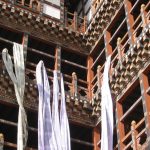 Pema patiently answered our more practical questions. “Most boys join a monastery around five or six years of age, chosen and encouraged by their families who consider it an honor to have a son in the community. Traditionally, monks have had better access to education than the rest of the population, though that is changing as our schools improve. Monks continue their education into specialties needed by the community.”
Pema patiently answered our more practical questions. “Most boys join a monastery around five or six years of age, chosen and encouraged by their families who consider it an honor to have a son in the community. Traditionally, monks have had better access to education than the rest of the population, though that is changing as our schools improve. Monks continue their education into specialties needed by the community.”
“Can the boys go home?” I asked.
“The boys visit their families on occasion,” explained Pema, “and the families come to the monastery when they are able, though many live too far away. Boys who decide not to stay are allowed to leave, but the family is expected to pay for the training received, which I think must put pressure on the boys to continue.”
Pema paused, then added, “One nice thing for the monk’s family is his availability when the family needs a blessing. We have a lot of those occasions; weddings, deaths, new babies, opening a new house, even the seasonal changes are all richer when a monk joins the celebrations and offers his blessings.”
Then I asked Pema, “The monks spend so much time sitting in meditation, in ceremonies, or in classes. How do they survive the cold and inactivity?”
Pema smiled and waved his hand toward the boys. “The cold temperature is just another challenge to overcome while meditating. Squirming is discouraged. It takes the boys awhile, but they learn to use the discomfort as a way to deepen their practice. They do have a chance to run around during their breaks. The older monks do walking meditations.”
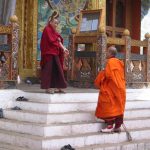 The monk I had seen on the balcony appeared later on the steps to the smaller hall, chatting amiably with another monk. At a distance, it looked like he might be carrying a whip, but on closer inspection, the strands were only cotton cloth. Another question for Pema: Was it symbolic?
The monk I had seen on the balcony appeared later on the steps to the smaller hall, chatting amiably with another monk. At a distance, it looked like he might be carrying a whip, but on closer inspection, the strands were only cotton cloth. Another question for Pema: Was it symbolic?
I thought, Surely, the monks guided the young miscreants toward appropriate behaviors without coercion in such a gentle practice.
Pema explained that the Buddhist monks live in the present moment. “What is, is.”
So the monks I thought might be judging the younger boys were, in fact, just observing them. Their very presence would be enough guidance for the boys who were learning the gentle lessons of Buddhism.
On the April day we visited, I was comfortable in long sleeves and pants. It was the edge of spring with pleasant weather, but I knew that many days at that high altitude are not warm. We did not see any fireplaces in the dzong, though it is possible the living quarters had some source of heat. Maybe the monks bulked up with layers of underclothes in the cold weather, like Pema did when we reached the chilly passes.
I was not tempted to romanticize a life at Punakha Dzong, as I do about some other situations I experience. At 64 years old, I was past the age of entry to commit to a life of austerity, but I respected the men and boys for their choices, and for their contributions to the life of the community. With all the changes as Bhutan continues to move toward modernity, I hoped the spirit of Buddhism would continue to thrive in Bhutan.